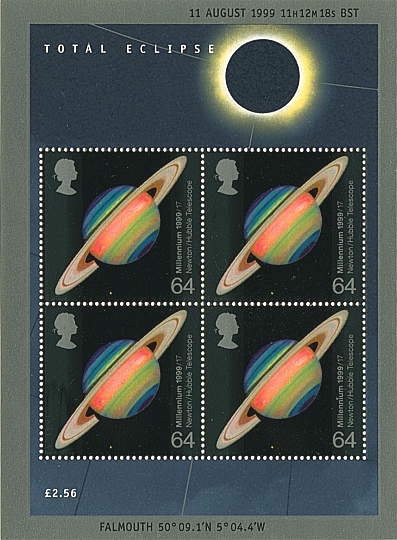1999 Total eclipse
On 1999 August 11 this sheet of four stamps was issued as a souvenir of the total eclipse of the Sun visible on that day from southwest England. Figures in the margin give the time of mid-eclipse and geographical coordinates for Falmouth, which had the maximum duration of totality in the British Isles, just over two minutes.
Perplexingly, the stamp is the same Newton/Hubble Space Telescope one that was issued a week earlier to honour Isaac Newton. The Royal Mail’s explanation for the repetition was that ‘Newton defined the physical laws governing motion, including the orbits of the planets’. Most people looking at the false-colour image of Saturn would doubtless have failed to make the connection with a total solar eclipse. Incidentally, the white dot underneath Saturn is not a flaw but one of its moons, Dione. This is barely visible on the previously released individual stamp – did someone try to touch it out?
What were those involved in this complete mis-fire thinking of?
Stanley Gibbons no. MS 2106
1999 Total eclipse (Alderney)
That’s more like it – a strip of stamps portraying the progress of the solar eclipse from beginning to end. Although most people went to Devon or Cornwall in an attempt to see this eclipse from British soil, the channel island of Alderney was also within the path of totality. In 1999 April the Guernsey Post Office, whose bailiwick includes Alderney, issued a set of six stamps with values from 20p to 64p designed by Victoria Kinnersly.
Early stages of the eclipse are shown on the two lowest-value stamps, while Baily’s Beads and flame-like prominences appear on the 30p stamp as the eclipse becomes total. The 38p stamp depicts the totally eclipsed Sun surrounded by its glowing corona. On the 44p stamp, the first sliver of returning sunlight appears at the Moon’s limb creating a diamond ring effect as totality ends.
The souvenir strip shown here includes an additional label at far right with no postal value which completes the sequence.
Scientifically accurate and attractive, although the colours were rather pale, this set was a worthwhile memento of a remarkable event.
Stanley Gibbons nos. A 125–30 (Sheet: MS A 131)

